Generating blog post ideas for your blog or freelance writing clients can be challenging. For yourself, it only becomes more difficult as the quantity of content on your blog grows.
And for writing clients that you don’t write for on-spec, there are days when you feel lost. Days, when the creative juices aren’t flowing, and you can’t for the life of you think of any blog post ideas.
I recently experienced both these problems. Firstly, after launching WriteWorldwide 4 months ago, and having published over 70 articles, myself and the entire team found ourselves scratching our heads in search of topics for blog posts. But thanks to some of the techniques in this post, we overcame this.
Secondly, I also blog for a client who I often pitch ideas to. Once approved, I compile a draft before proceeding. But, the other day I hit a brick wall and couldn’t think of anything. Even after thinking of an idea for a post and pitching it, she rejected it.
I knew I needed to change my approach. I did, and after sending six pitches, she was thrilled. Not only did she latch onto one of the ideas, but she liked many others. Only last week I completed one post that she paid for the same day. How did I do it? Again, I managed to generate several blog post ideas by using methods I discuss in this post.
Here are nine killer ways to create an endless stream of blog post ideas. If you ever feel like you’re running out of article ideas, consult this list.
#1 Ask Your Target Audience What They Want
If you have an email list, use it. Send an email asking your subscribers what their biggest struggles are, then write a blog post about it. At WriteWorldwide we used this technique in helping us create an actionable cheat sheet to help our subscribers. Below is the email we sent:
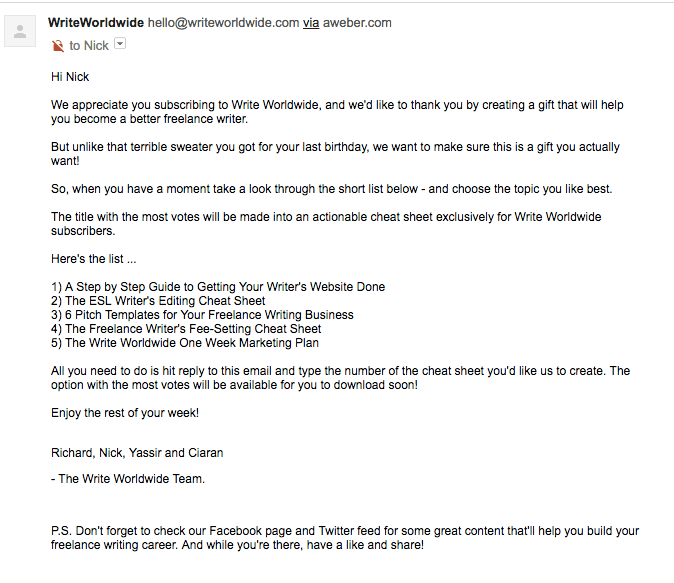
![]()
We gave our readers five options. The one with the most votes won. In this case, it was number three: 6 Pitch Templates For Your Freelance Writing Business. The result was the creation of our Pitching Template Cheat Sheet that provides several pitch templates you can use when pitching clients.
Or use Facebook. I’m part of several writing groups. They’re the perfect place if you need help, want to help others, or need ideas for new blog posts. I recently posted the question below on Facebook:

Admittedly, I already had a blog post idea in mind which led to the creation of 7 Common Problem’s Writers Face (And How to Overcome Them).
But I can turn each of the responses I received into new blog posts in the future. For instance, one person responded saying that their biggest struggle is launching their site.

From this response I immediately have two possible blog post ideas:
- How to Launch Your Freelance Writing Website (without experience)
- 10 Killer Tips to Position Yourself as a Writer.
#2 Consult Your Archives
As your blog grows, you may feel like you’re short of ideas. But by doing some digging, you’ll discover that the opposite is also true. By consulting previous posts, you may find that you’ve missed something or that the post sparks new article ideas.
For example, when we launched WriteWorlwide we created a post titled, How to Build Your Foundation as a Freelance Writer. After rereading it, I see that I could provide a post with more detail on how to launch a writer website (something we haven’t covered in-depth on the blog).
#3 Understand What Content Your Client Publishes
Chances are you’ll eventually have a client who wants YOU to generate article ideas. What do you do? Well to start with, you need to have an understanding of the content they write about, the topics they cover, and who their target audience is.
By understanding this, you’ll understand their customer pain points. You’ll not only never struggle with content ideas, but the ideas you deliver will be in line with what your client wants. If you’re still struggling, it’s time to ask your client.
#4 Ask Your Client What Topics They Want to Focus on
Whether you’re starting a relationship with a client or already have one, you need to check in often to understand what their content focus is.
Why? Because the focus often shifts. Only recently a client told me that they wanted to concentrate on middle to lower funnel content, and on invoicing and financial health topics. So, make sure you’re keeping up with that change so that you can deliver the right content.
Below is an example of this in action.
I sent the following email to a client asking if there was anything that I could improve.
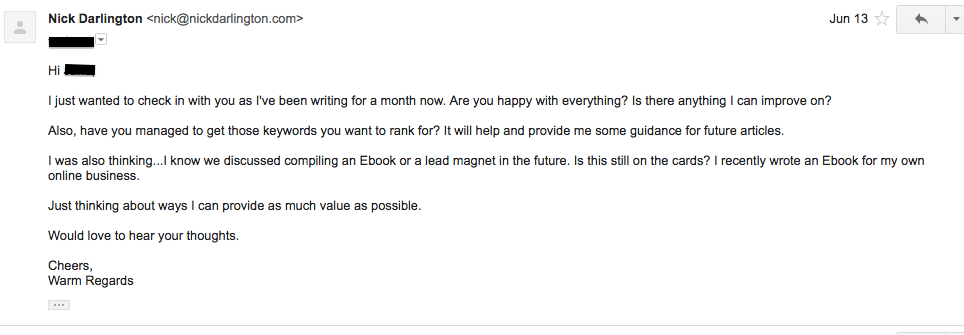
Admittedly I didn’t ask what specific topics they want to cover, but the response I received after a chain of emails proves that clients want to help. In fact, more than often they’re happy to because they know it’s to their benefit. Here’s an email where the client stated what topics needed attention.
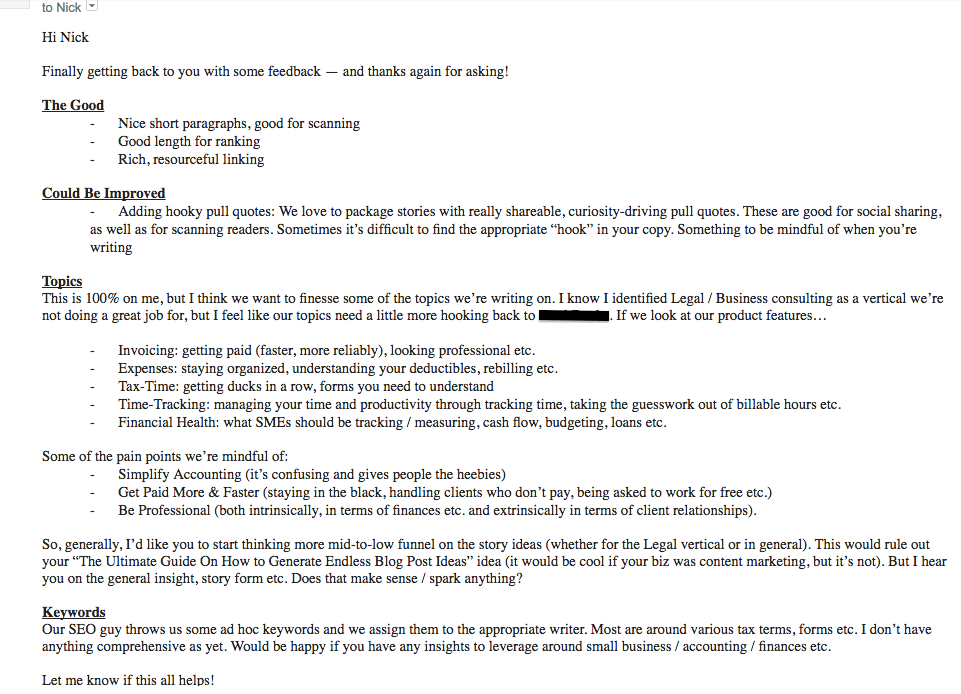
From that, I had direction. I then used Google and the Tweak Your Biz Title Generator. Simply enter a topic, indicate if it’s a noun or verb and hit enter. I used this technique to generate six unique blog post ideas which the client loved.
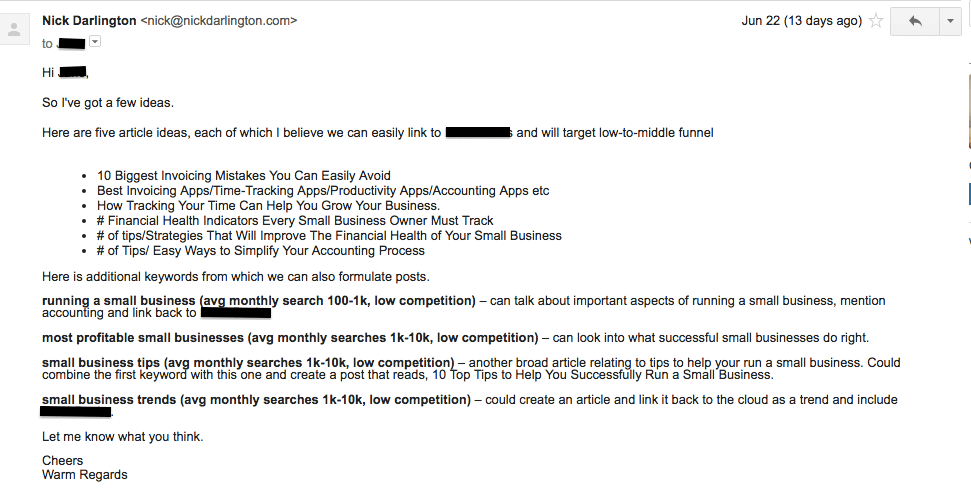
#5 Use Title Generators
Besides title generators such as Tweak Your Biz you can use:
- Portent’s Content Idea Generator
- SEOPressor’s Blog Title Generator
- Hubspot’s Blog Topic Generator
- Impact Blog Title Generator
#6 “Steal” Ideas from Competitors
Read blogs in your niche, see what they’re posting, how you can provide a different angle or whether those posts spark ideas. At WriteWorldwide we consult blogs like Make a Living Writing, Writing Revolt, Writers in Charge, FreelancerKenya and Goins, Writer.
For instance, when visiting Writing Revolt I came across a post titled, Freelance Blogging: How to Get Paid $200-$400+ Per Post. Immediately this triggered an idea. I recently landed two of my highest paying blogging clients for $250 and $300 per 1200-1500 words.
I’m in the perfect position to write an article about this and provide in-depth insight into how I did it. A possible title: How I Landed a $300 Per Blog Post Client (Within My First Year of Freelance Writing). The title may need some work, but you get the idea.
Similarly, Carol Tice recently posted the article 3 Time-Wasting Blunders That Kill Your Freelance Writing Income. From that article I came up with the following idea: 5 Common Freelance Writing Mistakes (And How to Overcome them)
#7 Use Quora
Quora is a social media network where people ask and answer questions. Once you’re signed up, you can choose what topics to follow. Click on a subject to see what questions people are asking and generate blog post ideas from that.
For instance, using my Quora profile and clicking on one of the topics I’ve saved, the first question that pops up is, How can I get started freelance writing? Possible blog post idea right there.
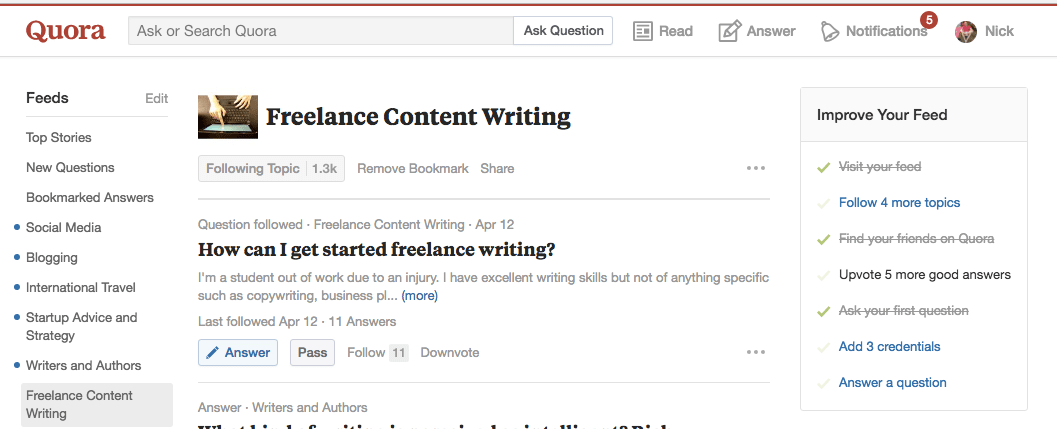
When scrolling down, there are many other questions such as where to find good freelance writing jobs and whether Quora is a good platform for new writers looking for work.

Follow the same process to discover content gems.
If you want to take things further and
#8 Conduct Keyword Research
Conducting keyword research lets you discover what people in a particular niche are typing in search engines. From there you can create
The ability to conduct keyword research is a great skill to have as a freelance writer. Not only will it help to generate article ideas but it shows your client that you can provide value beyond writing.
You may be thinking: How do I do keyword research? Well, it’s simple. I’ll show you how to do it using the Google Keyword Planner. Take note that it’s not difficult; a year ago I knew nothing, and I have since taught myself.
Step 1: Create an AdWords Account if you don’t have one.
Step 2: Create an ad and pause it (you can’t skip this step).
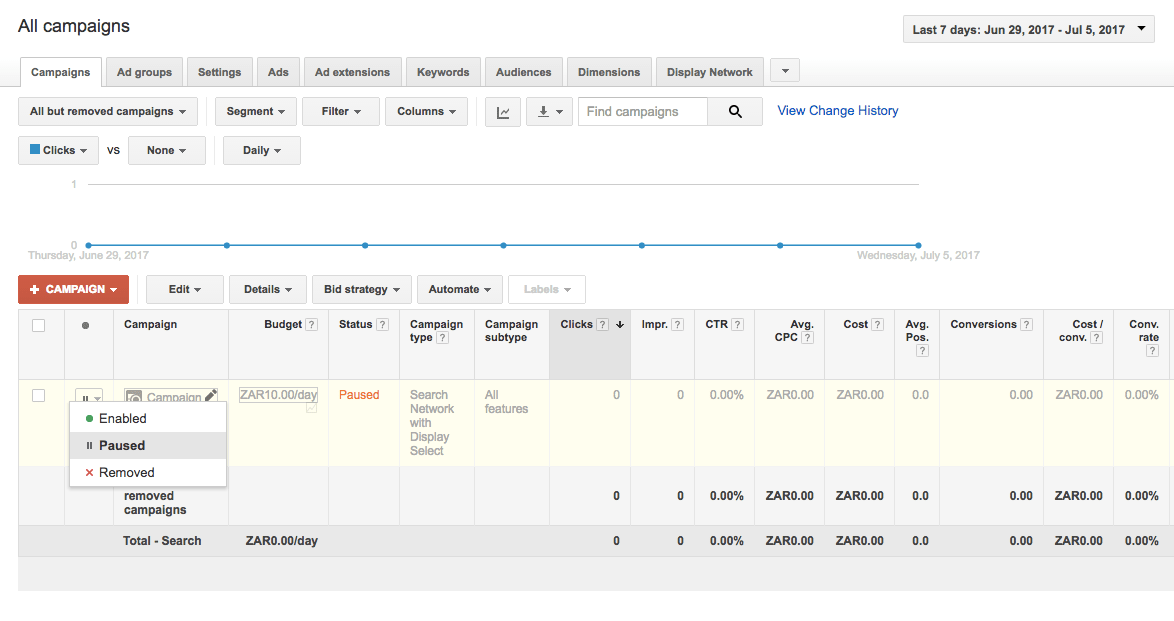
Step 3: Access the Keyword Planner under “tools”.

Step 4: Search for ideas in your niche/industry (in the below example I’ll use freelance writing).
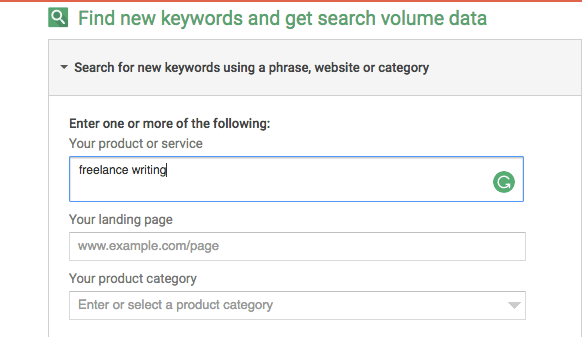
Step 5: Apply filters. Targeting low competition keywords is a good option for smaller blogs as the chances of ranking for those keywords is higher.
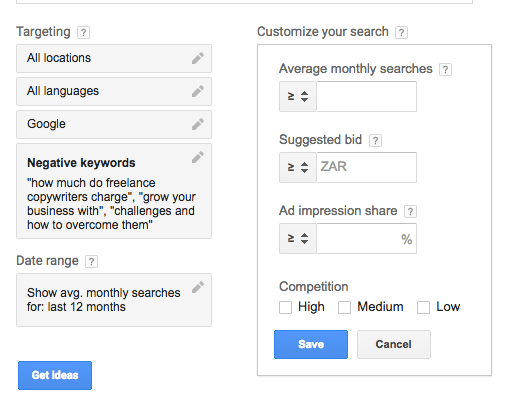
Step 6: Search for ideas by clicking “Get Ideas”.
Step 7: Look
In my example, I’m only interested in long-tail keywords with low competition. Long tail keywords like “freelance writing gigs” and “how to become a freelance writer” are good places to start.


I could create several posts
- 20 of The Best Places to Find Freelance Writing Gigs
- How to Become a Freelance Writer in Two Months
- What They Don’t Tell You About How to Become a Freelance Writer
#9 Use Online Tools and Resources
The final way to make sure you never run out of blog post ideas is by using the many online tools and resources available. Ciaran wrote an excellent post about seven writing resources to help you generate article ideas. He listed several books like
While both these tools provide inspiration for your next blog posts by revealing the most shared content for a topic, we’ll focus on BuzzSumo. You can use it for free, but there are search limitations. Here’s how it works:
Step 1: Enter a topic and click “Go”. We’ll use “freelance writing jobs online”.
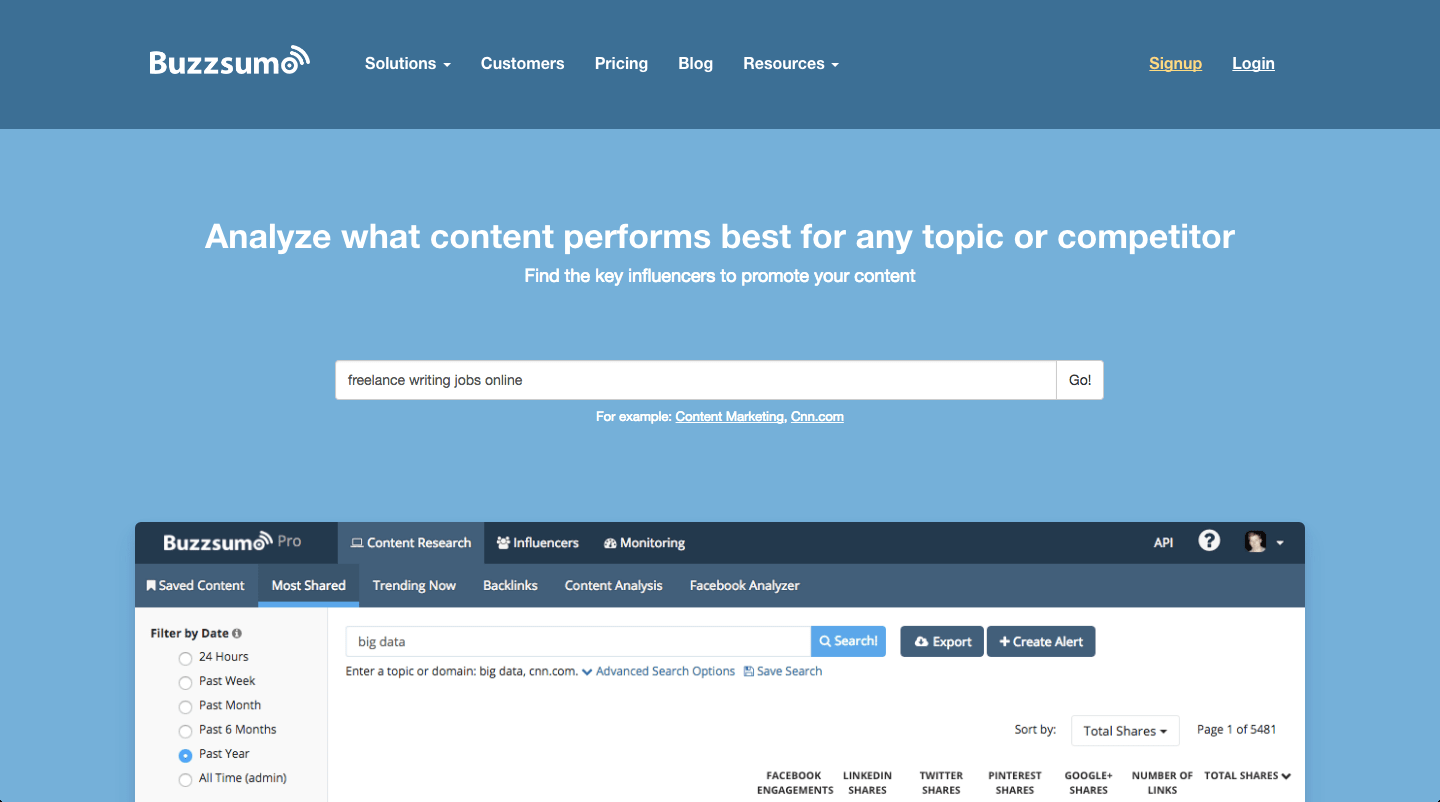
Step 2: See which content is the most shared. In this example, it’s an article by Carol Tice.
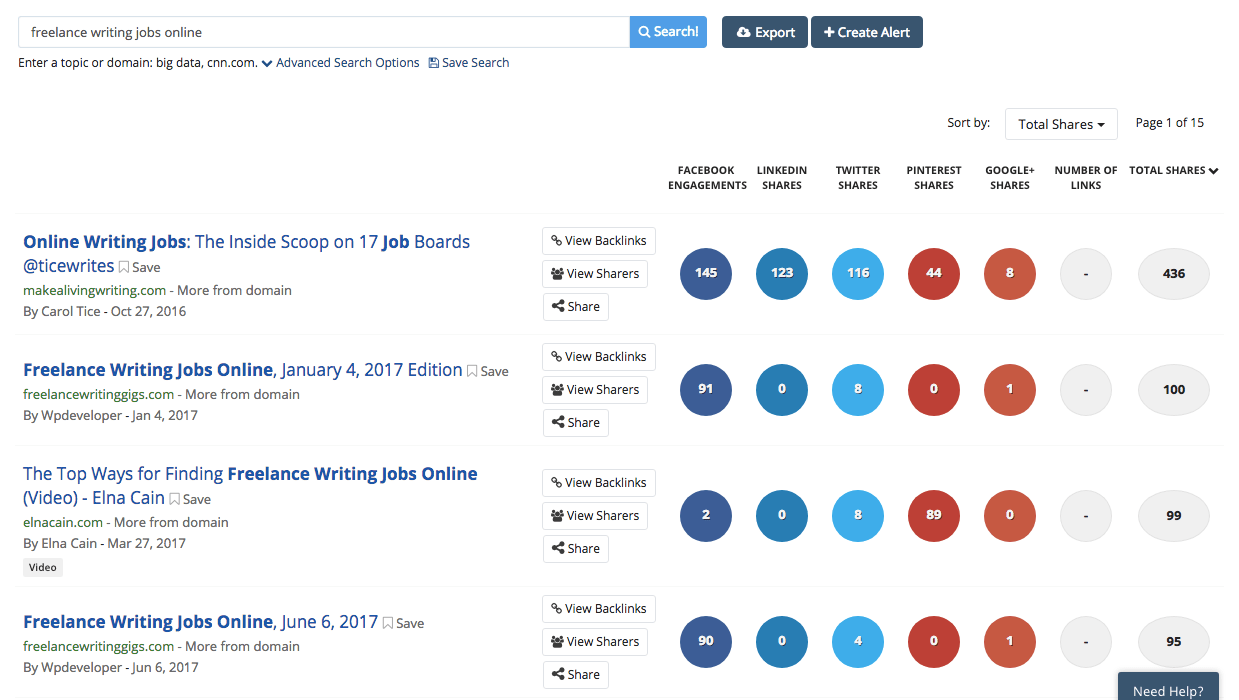
Step 3: Create an article with a different angle or consider how you could make it even better.
Bonus Tip: Use the Skyscraper Technique to find link worthy content, make it better, and reach out to the right people to get backlinks. For a full explanation of this method, read Bryan Dean’s article, Link Building Case Study: How I Increased My Search Traffic by 110% in 14 days.
Wrapping Up
Generating new blog ideas can be a challenge, but it needn’t be if you use these nine methods:
- Ask your target audience what they want
- Consult your archives
- Understand what your content your client publishes
- Ask your clients what topics they would like to concentrate on
- Use title generators
- “Steal” ideas from competitors
- Use Quora
- Conduct keyword research
- Use online tools and resources
You’ll never find yourself scratching your head in search of blog post ideas again. Do you use other methods to generate new ideas for blog posts? Let us know in the comments.
P.S. If you found this post interesting then you may be interested in this downloadable:




This article is priceless, genius! Well done!
Hi Abu,
Thanks! Glad you enjoyed it.
Cheers,
Wow! This is a massive post worth its weight in cyber gold!
Thank you for the resources you listed. Will definitely follow them up.
Cheers.
Hi Katopeka,
Thanks for the email and I’m glad you found the post valuable. Let us know if you have any other ideas to generate blog post ideas.
Cheers,
Wow! What an awesome post. It was very timely. Thanks, Nick, for going in-depth to cover this subject.
Hi Bamidele,
Thank you for the comment. You’re welcome.
Cheers,
Hey Nick,
I think you’d find IdeaStream.io useful. It’s specifically designed to make long-term ideation simpler and faster.
It sends you an email everyday with the top questions your audience is asking.
Hi Dale,
Thanks for the comment. I signed up and will give it a go. My only concern is that you only allow one channel. Thereafter you ask people to pay for the service. With the many tools online to find solid ideas for free, will it work? Only time will tell. But really love the fact that you aggregate questions on Quora. I’ve recently taken to scouring the pages of Quora for some gems to write about and, I’ve found a few.
Cheers
This is a very good tip particularly to those new to the blogosphere.
Simple but very accurate information… Many thanks for sharing this one.
A must read post!
Hi Marisol,
Thank you. Simplicity is king 🙂
Cheers,
Nick
Very thought provoking, Nick. Gives me a lot to think about in my blogging career. Generating ideas if often hard, but these ideas are great! Thanks so much for the help!
Keep on working, great job!
maglia lazio
Hi Maglia,
Thank you 🙂
Cheers,
Nick
Hi Maglia,
Thank you.
Cheers,
Nick